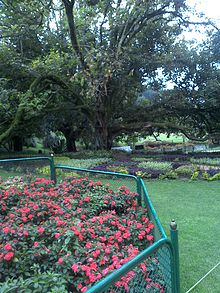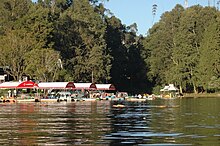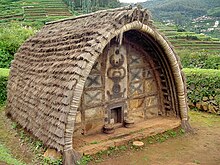Ooty features a subtropical highland climate (Cwb) under Köppen climate classification.
Despite its location in the tropics, in contrast with most of South
India, Ooty generally features mild conditions throughout the year.
However, night time in the months of January and February is typically
cold. Generally, the town appears to be eternally stuck in the spring
season.
Temperatures are relatively consistent throughout the year; with
average high temperatures ranging from about 17–20 °C (63–68 °F) and
average low temperatures between approximately 5–12 °C (41–54 °F).
The highest temperature ever recorded in Ooty was 25 °C (77 °F),
which by South Asian standards is uncharacteristically low for an
all-time record high temperature. The rainy season in Ooty is generally
cool and windy with high humidity. The wind chill may fall to as low as
5 °C (41 °F) during the day time. Wind is always high throughout the
year. The lowest temperature was −2 °C (28 °F).
The city sees on average about 125 cm (49 in) of precipitation
annually, with a marked drier season from December through March.
Places of interest
Ooty is situated in the Nilgiri Biosphere Reserve.
Many of the forested areas and water bodies are off-limits to most
visitors to protect this fragile ecosystem. Some areas of the Biosphere
Reserve have been earmarked for tourism development, and steps are being
undertaken to open these areas to visitors whilst conserving the area. It is situated at an altitude of 2,240 metres (7,350 feet) above sea level.
- Gardens and parks
The Government Botanical Garden
The Government rose garden (formerly Centenary Rose Park)
[ is the largest rose garden in India.It is situated on the slopes of the Elk Hill in Vijayanagaram of Ooty town.
at an altitude of 2200 meters. Today this garden has one of the largest
collection of roses in the country with more than 20,000 varieties of
roses of 2,800 cultivars. The collection include hybrid tea roses, Miniature Roses, Polyanthas, Papagena, Floribunda, Ramblers, Yakimour and roses of unusual colours like black and green.
Xerochrysum bracteatum - Everlasting flower from Ooty
The 22-acre (89,000 m
2) Ooty Botanical Gardens was laid out in 1847 and is maintained by the Government of Tamil Nadu.
The Botanical Garden is lush, green, and well-maintained. A flower show
along with an exhibition of rare plant species is held every May. The
gardens have around a thousand species, both exotic and indigenous, of plants, shrubs, ferns, trees, herbal and bonsai plants.
[ The garden has a 20-million-year-old fossilised tree.
Deer Park is located on the edge of Ooty Lake. It is the highest
altitude zoo in India aside from the zoo in Nainital, Uttarakhand. This
park was formed to house a number of species of deer and animals.
- Lakes and dams
Ooty lake covers an area of 65 acres.The boat house
established alongside the lake, which offers boating facilities to
tourists, is a major tourist attraction in Ooty. It was constructed in
1824 by John Sullivan, the first collector of Ooty. The lake was formed by damming the mountain streams flowing down Ooty valley.
The lake is set among groves of Eucalyptus trees with a railway line
running along one bank. During summer season in May, boat races and boat
pageantry are organised for two days at the lake.
Boating in Pykara Lake in Ooty
Pykara is a river located 19 km from Ooty.
[ The Pykara is considered very sacred by the Todas.
The Pykara river rises at Mukurthi peak and passes through hilly tract,
generally keeping to North and turns to West after reaching the
Plateau's edge. The river flows through a series of cascades; and the last two falls of 55 meters and 61 meters are known as Pykara falls.
The falls are approximately 6 km from the bridge on the main road. A
boat house by the Pykara falls and dam is added attractions to the
tourists. Kamaraj Sagar Dam (also known as Sandynalla reservoir)is located at a distance of 10 km from the Ooty bus stand.
It is a picnic spot and a film shooting spot on the slopes of the Wenlock Downs.The various tourist activities the dam include fishing and studying nature and environment.
Parsons Valley Reservoir is the primary water source for the town and
is mainly in a reserved forest and is thus largely off-limits to
visitors. Emerald Lake, Avalanche Lake and Porthimund Lake are other lakes in the region.
- Reserve forests

The Pine Forest in Ooty
-
Tiger Safari in Mudumalai Tiger Reserve
Doddabetta
is the highest peak (2,623 m) in the Nilgiris, about 10 km from Ooty.
It lies at the junction of the Western and Eastern Ghats surrounded by
dense Sholas. Pine forests situated between Ooty and Thalakunda
is a small downhill region where pine trees are arranged in an orderly
fashion. Wenlock Downs is a grassland area typical of the original
bioscape of the Nilgiris with gently undulating hills. Mudumalai National Park and tiger reserve lies on the north western side of the Nilgiri Hills.
The sanctuary is divided into 5 ranges - Masinagudi, Thepakadu,
Mudumalai, Kargudi and Nellakota. Here one can often spot herds of endangered Indian elephants, vulnerable gaur, and chital. The sanctuary is a haven for Bengal tigers and Indian leopards and other threatened species. There are at least 266 species of birds in the sanctuary, including critically endangered species like the Indian white-rumped vulture and the long-billed vulture. Mukurthi National Park is a 78.46 km2 protected area located in the south-eastern corner of the Nilgiris Plateau west of Ooty. The park was created to protect its keystone species, the Nilgiri tahr.The Western Ghats, Nilgiri Sub-Cluster (6,000 km2 (2,300 sq mi)), including all of Mudumalai National Park, is under consideration by the UNESCO World Heritage Committee for selection as a World Heritage Site.
- Tribal huts and museum
There are a few Toda huts
on the hills above Botanical Garden, where Todas still dwell. There are
other Toda settlements in the area, notably Kandal Mund near Old Ooty.
Although many Toda have abandoned their traditional distinctive huts for
concrete houses,
a movement is now afoot to build tradition barrel-vaulted huts and
during the last decade forty new huts have been built and many Toda
sacred dairies renovated.
The Tribal Museum is part of the campus of Tribal Research Centre
which is in Muthorai Palada (10 km from Ooty town). It is home to rare
artefacts and photographs of tribal groups of Tamil Nadu as well as
Andaman and Nicobar Islands and anthropological and archaeological
primitive human culture and heritage. The Tribal Museum also displays
houses belonging to Toda, Kota, Paniya, Kurumba and Kanikarans.
- Nilgiri Mountain Railway
The Nilgiri Mountain Railway was built by the British in 1908, and was initially operated by the Madras Railway Company. The railway still relies on its fleet of steam locomotives.NMR comes under the jurisdiction of the newly formed Salem Division. In July 2005, UNESCO added the Nilgiri Mountain Railway as an extension to the World Heritage Site of Darjeeling Himalayan Railway, the site then became known as "Mountain Railways of India."
[ after it satisfied the necessary criteria, thus forcing abandonment of
the modernisation plans. For the past several years diesel locomotives
have taken over from steam on the section between Coonoor and Udagamandalam. Local people and tourists have led a demand for steam locos to once again haul this section.
- Historical buildings
Stone House is the first bungalow constructed in Ooty. It was built by John Sullivan and was called as Kal Bangala
by the tribals (Kal means stone in local tribal language). John
Sullivan started building Stone House in 1822, acquiring land from the
Todas at one rupee an acre.Today, it is the official residence for the principal of the Government Arts College, Ooty.
St Stephen's Church is located on the road to Mysore in Ooty, in the state of Tamil Nadu, India. It is one of the oldest churches in the Nilgiris district. The church dates back to the 19th century. Stephen Rumbold Lushington, the then governor of Madras,
who keenly felt the need for a cathedral exclusively for the British,
in Ooty, laid the foundation for the church on 23 April 1829, to
coincide with the birthday of King George IV. St Stephen's Church was consecrated by John Matthias Turner, Bishop of Calcutta, on 5 November 1830. It was thrown open to public communion on Easter Sunday 3 April 1831. It came under the Church of South India in 1947. The architect in charge was John James Underwood, Captain, Madras Regiment.
In 1882 the rules and game of snooker were first drafted and codified
in the "Ooty Club". The club still houses the billiards table that was
used.
The nearest airport is Coimbatore,
around 96 km (60 mi) away and Major International Airport is Bengaluru
(Kempegowda International Airport 273 km away). Ooty has three helipads,
one at Theettukal and two at Kodanad. The Theettukal helipad was
approved by Airports Authority of India for defence and VIP services. Pawan Hans was supposed to start its service with Bell 407,
but being present amidst farmland, dislocation of the farm animals
there has put the operations on hold for commercial activities.













